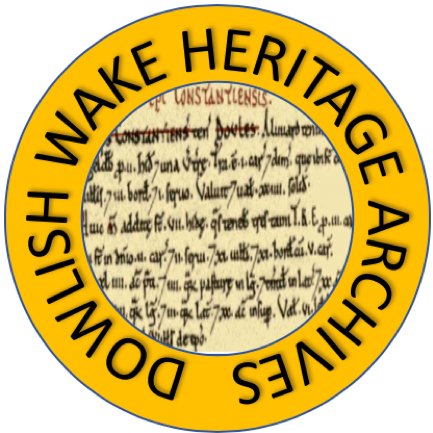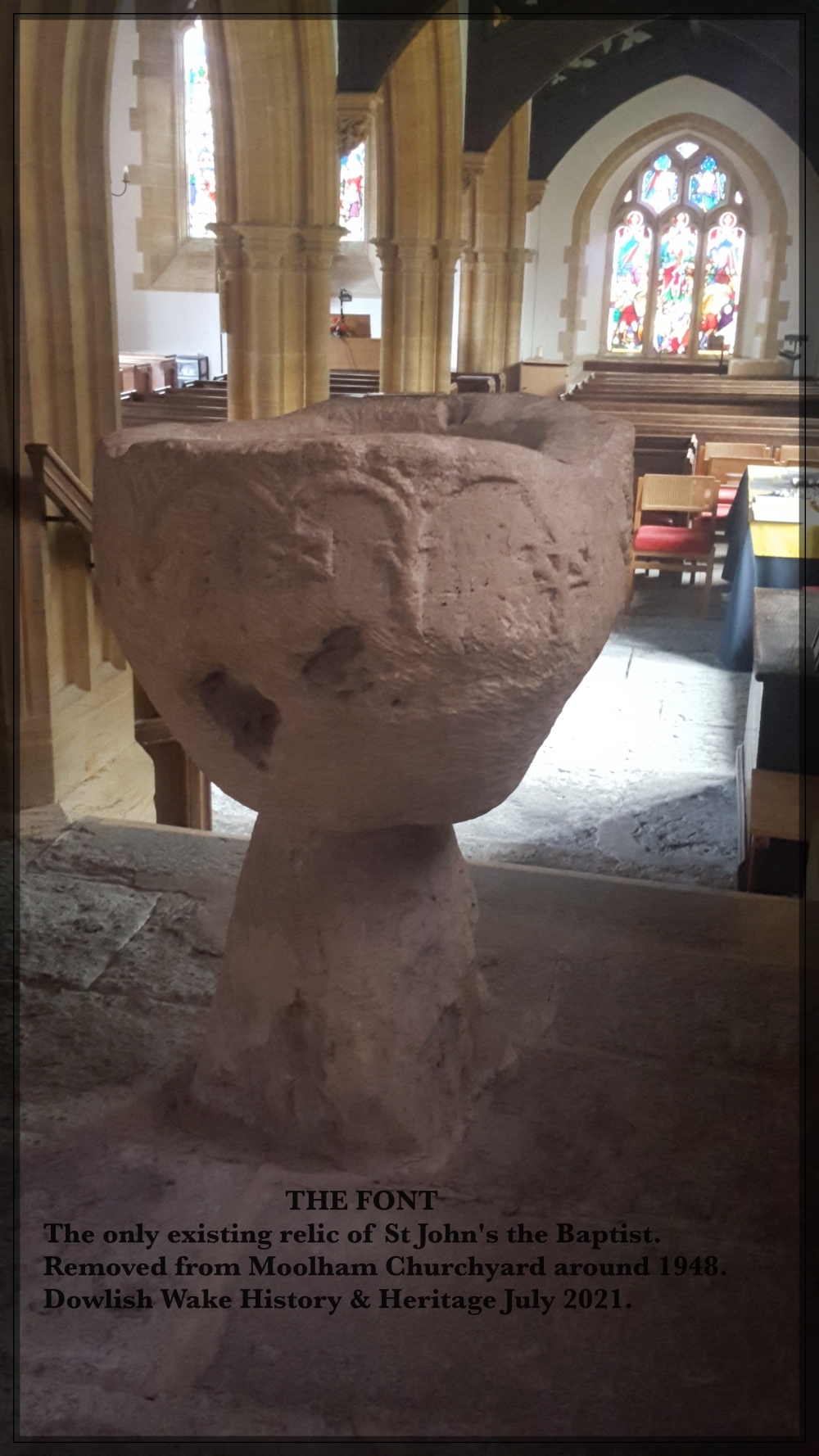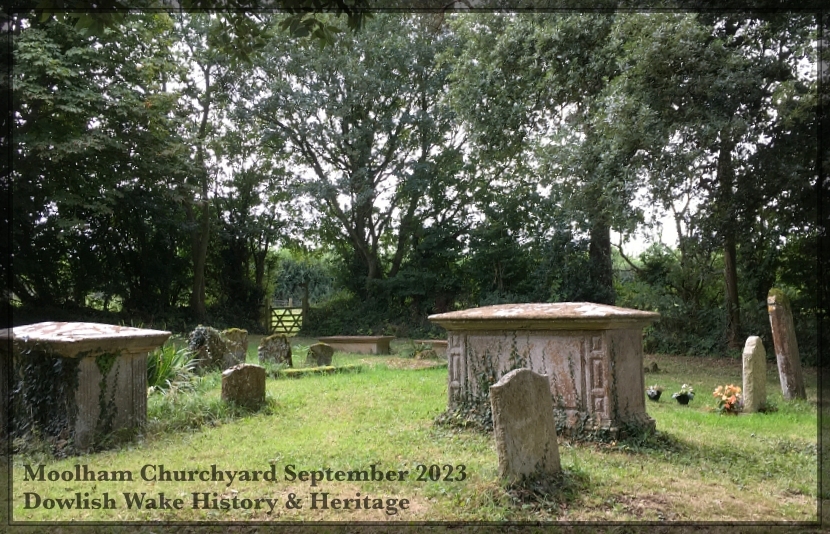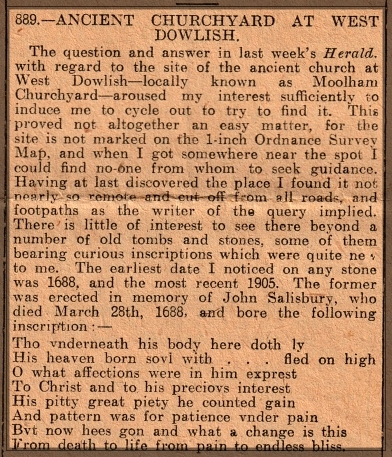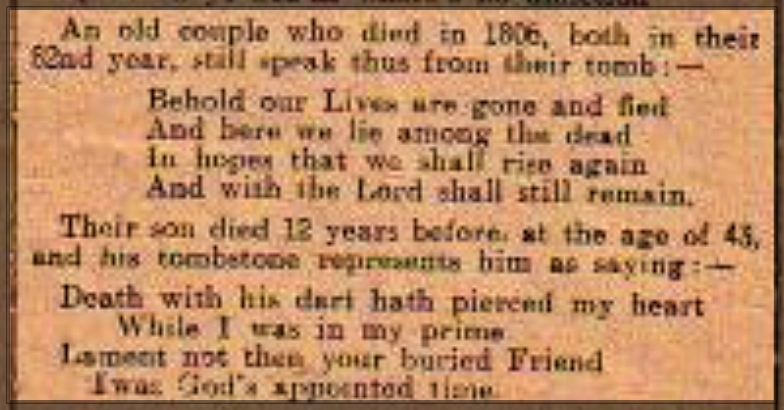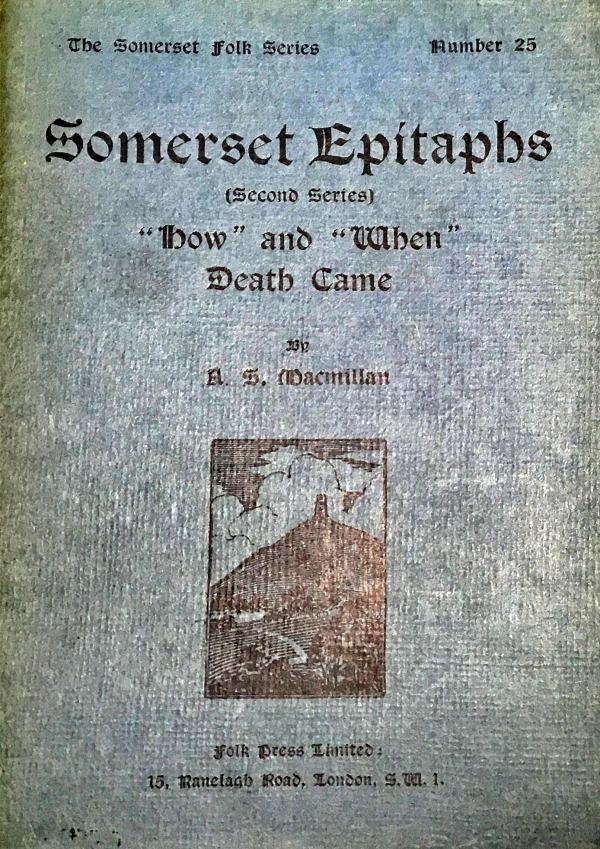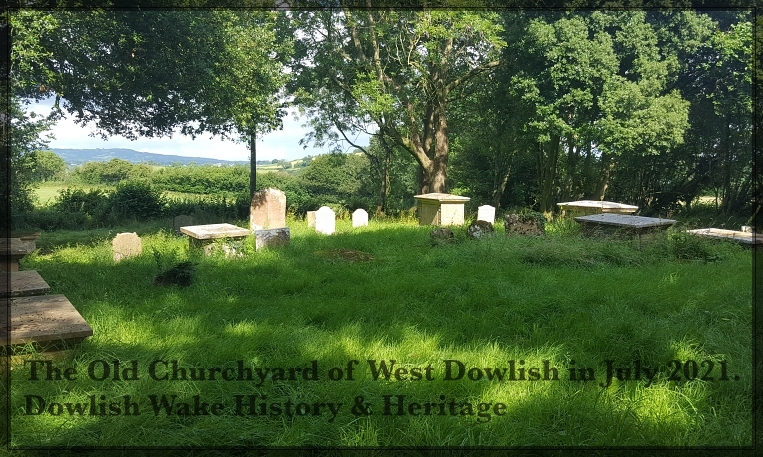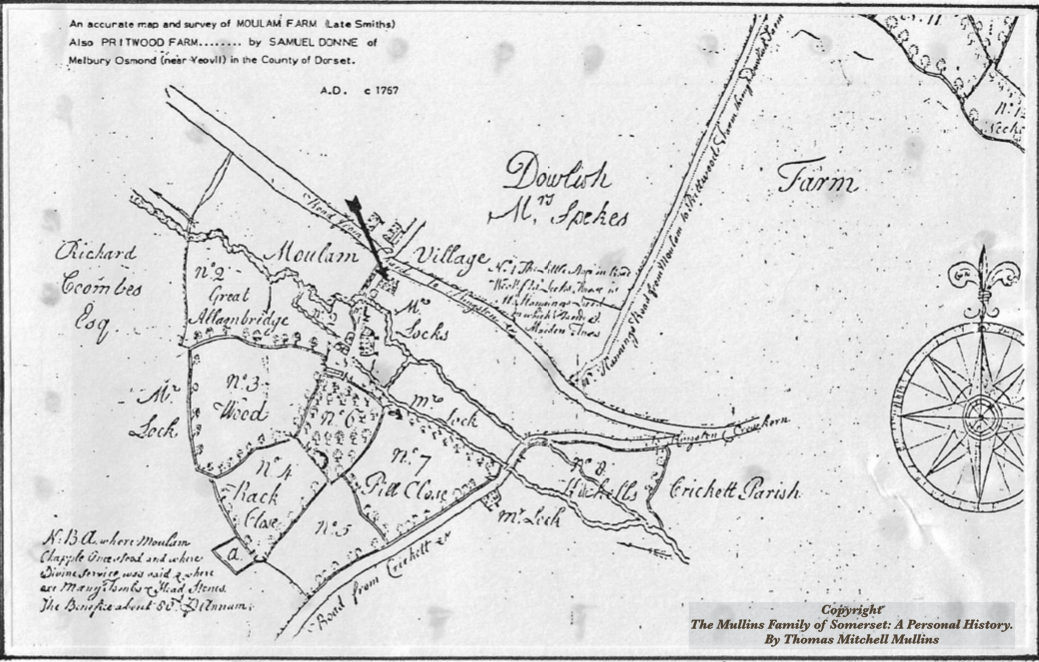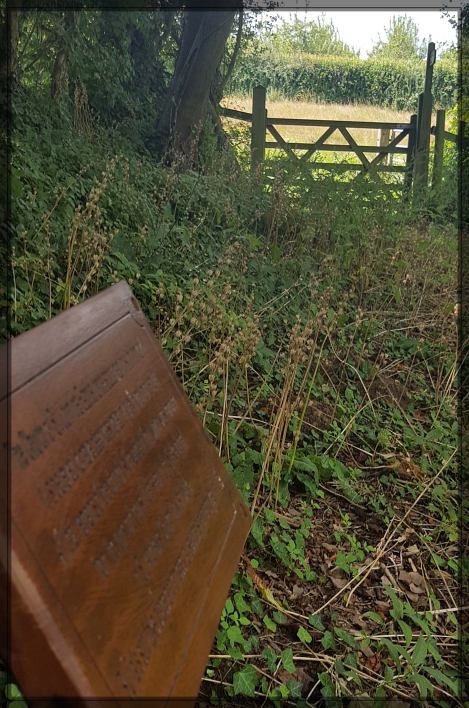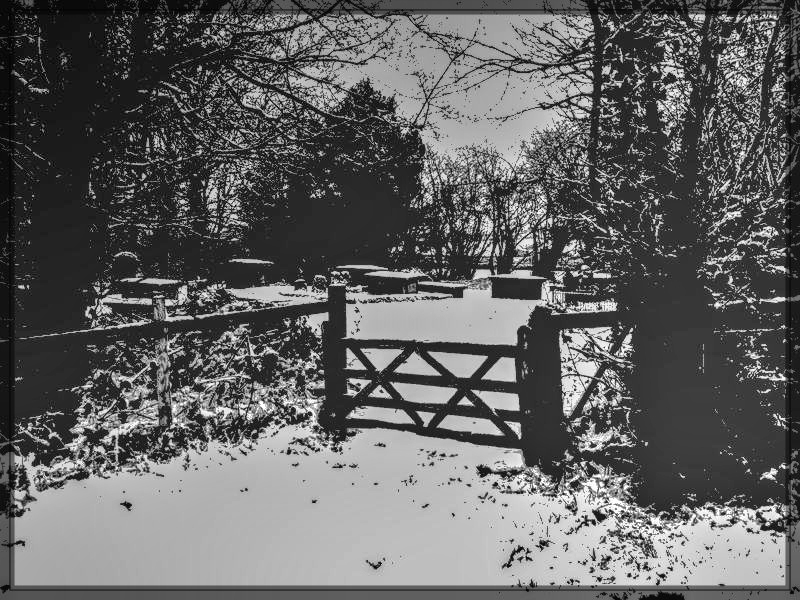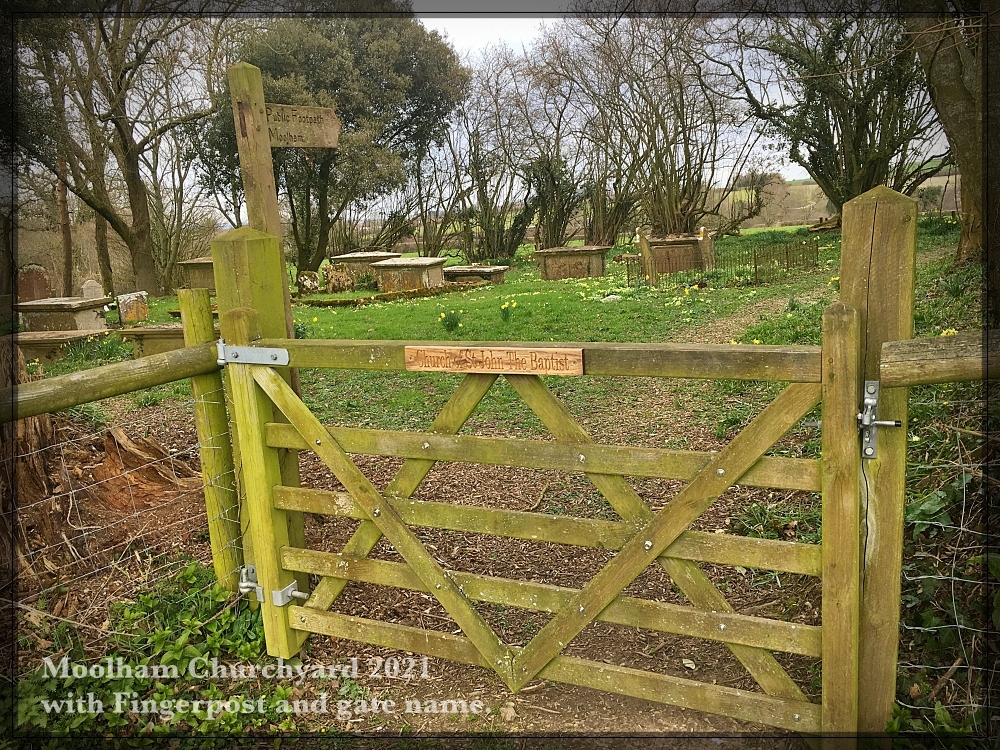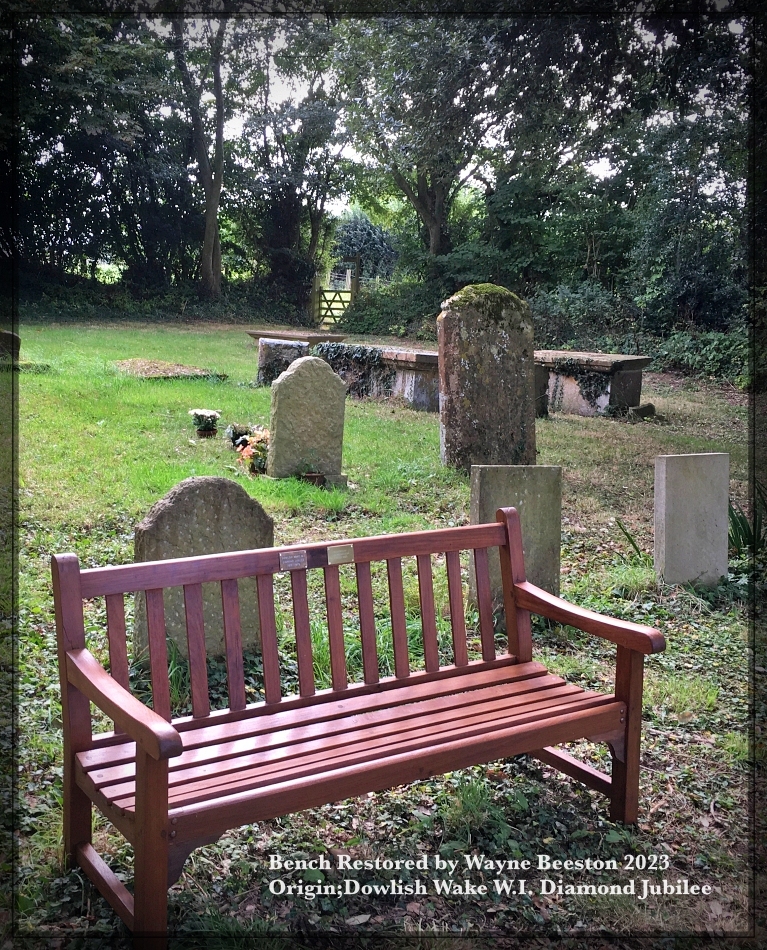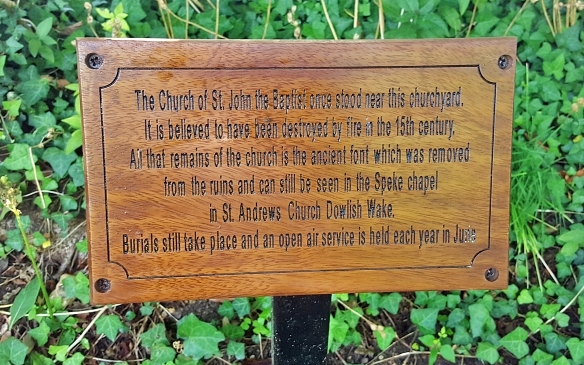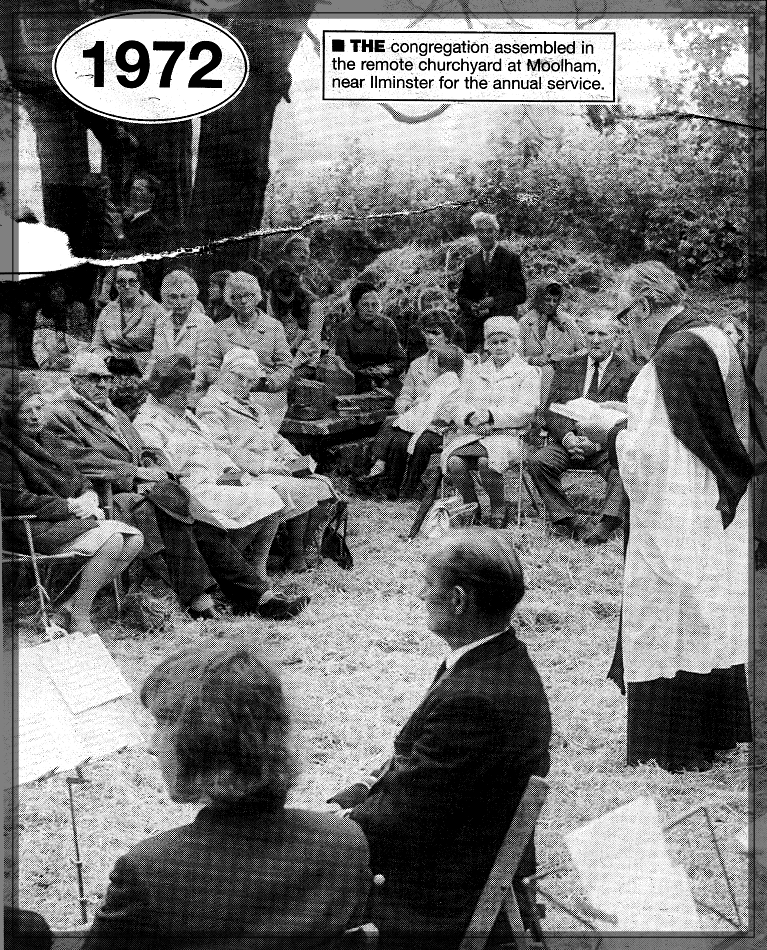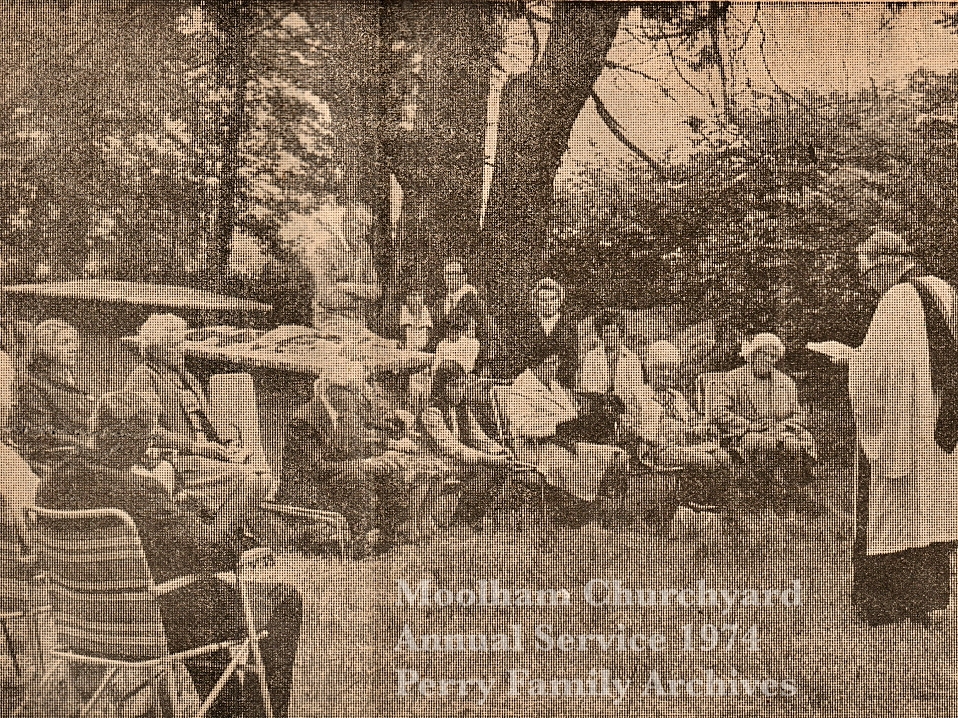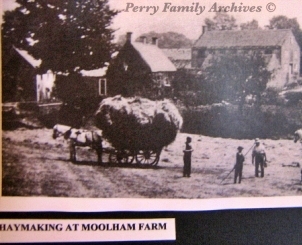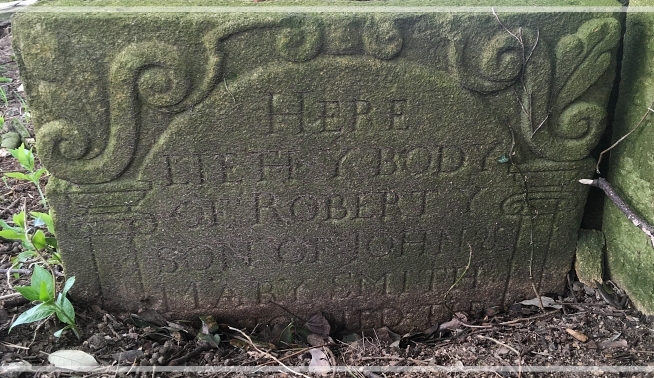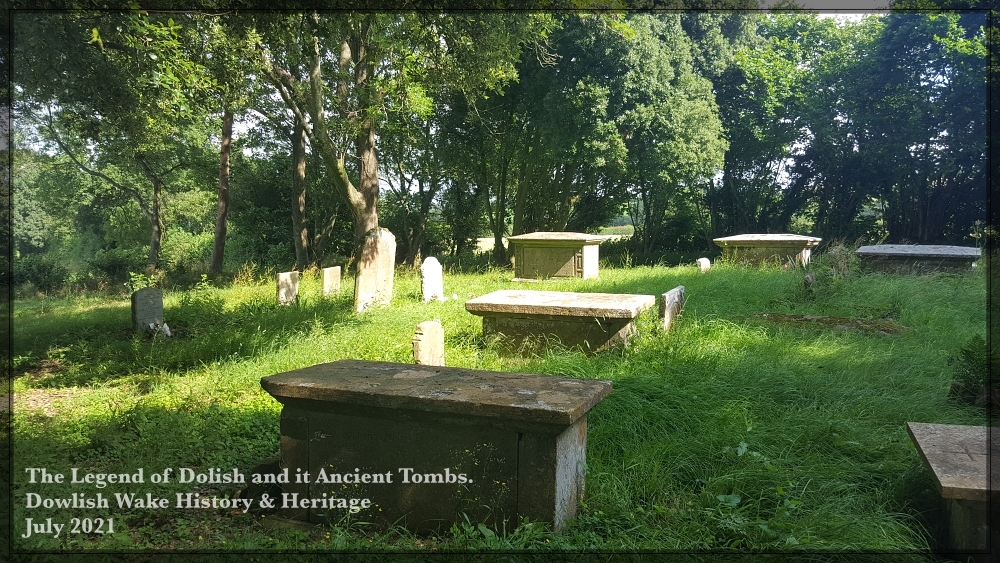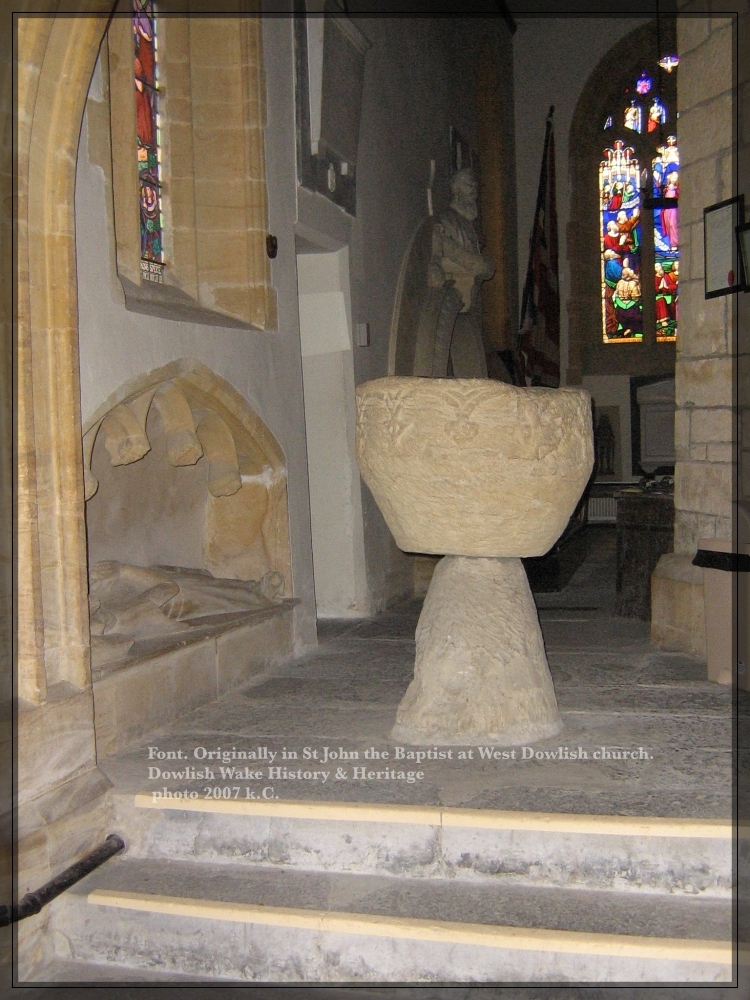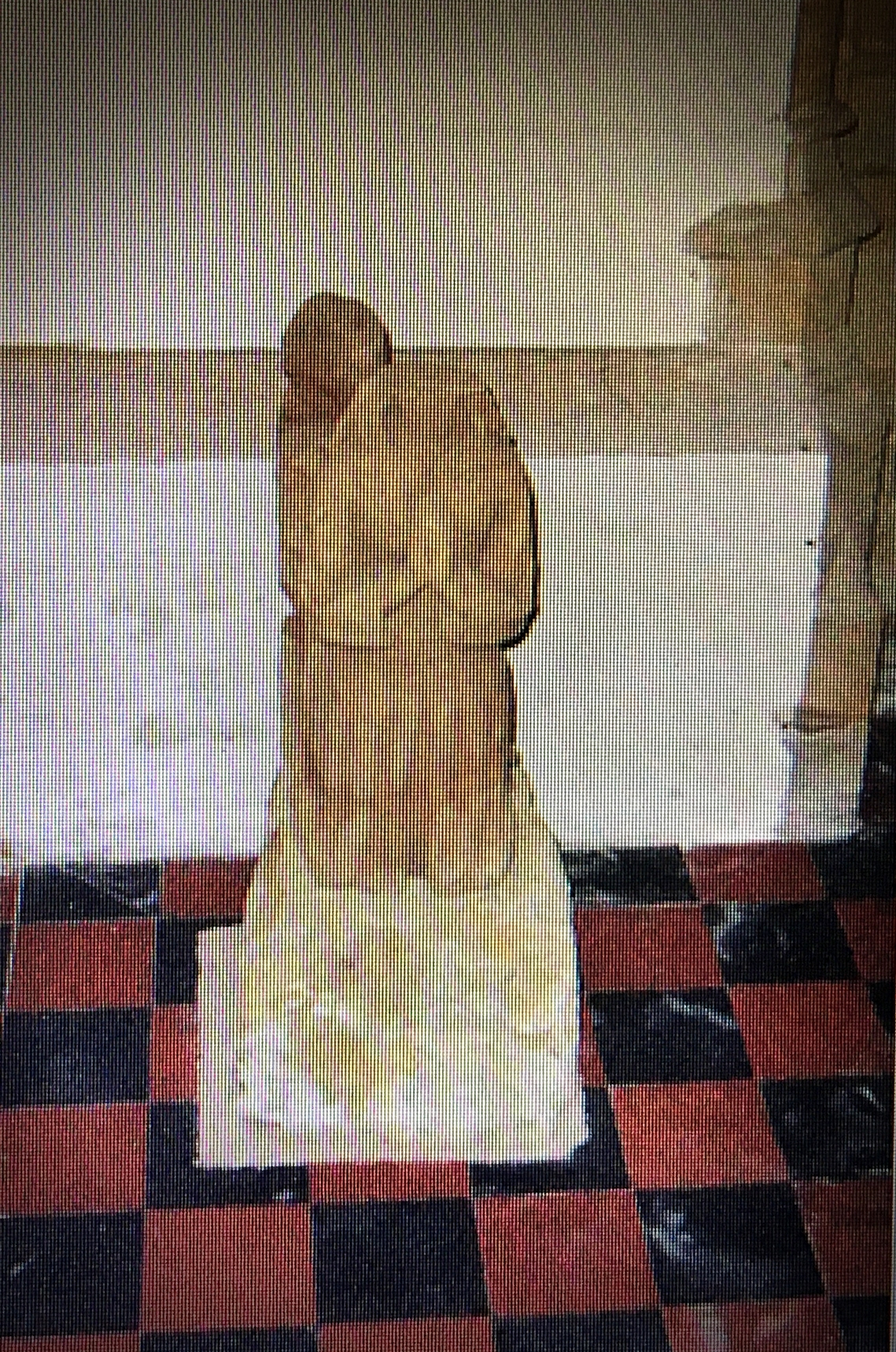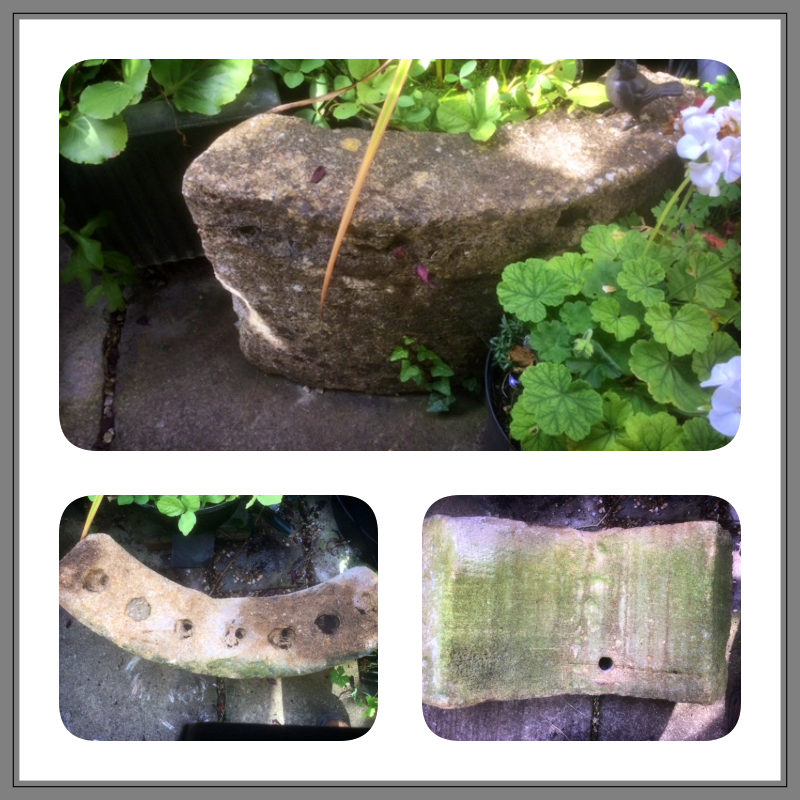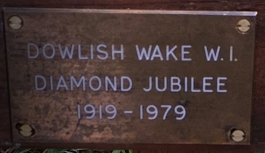West Dowlish Church - St John The Baptist.
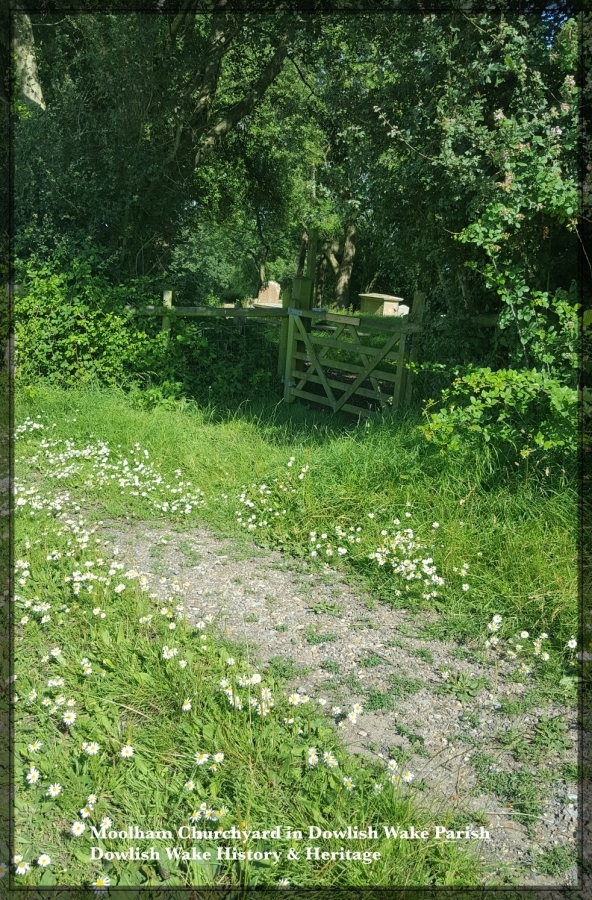
The Church of St John the Baptist no longer exists, and West Dowlish has a churchyard without a Church. The actual location of the church has prompted many a conversation over previous centuries. The following transcripts & notes are brought together here for present-day readers, who too, can ponder the absence of a church that once stood in Moolham, West Dowlish.
West Dowlish was at one time a separate parish to East Dowlish/Dolish, [Dowlish Wake]. Some talk of the ‘deserted village’ of West Dowlish. Others refer to the ‘shrunken village of Moolham’. We are told that sometime before 1575 its church, which had been dedicated to St John the Baptist had been destroyed by fire. All that remained of the church, is the ancient limestone font which can still be admired, as it was placed within the Dowlish Wake church of St Andrews.
A visit to the churchyard at Moolham is delightful in any season, and we have great appreciation of villagers that have helped with the preservation of it.
To all who have asked the question, was there once, a church in that churchyard?. The answer is yes, documentation resulting from a questionnaire sent out to all English parishes in the year 1705, clearly confirms the existence of a chapel at West Dolish/Dowlish [Moolham Churchyard].
St John’s – West Dowlish
In 1705 a nationwide survey ‘The Present State of Parish-Churches.’ Questionnaires sent to ‘The Reverend the Minister of every Parochial Church or Chappel in England’. Ordered by the then Secretary of State these returns for Somerset, importantly for us, include Dowlish Wake & West Dowlish with mention of St John’s 'Chapple'!
‘East Dolish alias Dowlish Wake is a rectory. The tythes are not impropriated, but by means of an ancient custom or pretended modus, the patron’s estate of abouth £80 per annum pays only 10s per annum to the minister. The patrons name is John Speke, esquire. The church belongs to the arch-deaconry of Taunton in Somerset. The value in the Queen’s Books is about eight pounds per annum’.
‘There was anciently a chappel at West Dowlish, call’d St. John’s chappel. The ruins remain and the inhabitants burie in the churchyard, but the chappel demolished is now become a sinecure, value about £30 per annum. The patron John Speke, esquire. Never given with East Dowlish in the memory of man, but is now enjoyed by Mr. John Prichard, vicar of Whitelackington’.
The results of this early survey contained in five small volumes housed in Lambeth Palace library, the author of the questionnaire; ‘A divine of the Church of England’. There are some 1,606 returns in this collection, known as Notitia Parchialis, the project connected to the previous year’s ‘Queen Anne’s Bounty’. Source page 80, volume 112 Somerset Archaeology and Natural History’.
Official records of the church/chapel are almost non-existent [This churchyard variously referred to as; Moolham, Moleham, Moulham, Oxenford, and West Dowlish churchyard].
Above, map from that period kindly shared by the family of Thomas Mitchell Mullin, whose ancestors farmed in Moolham.
The only existing relic, the font, had long been removed to St Andrew's Church in Dowlish Wake, where it still stands.
All these years later, the summer blessing in the churchyard an annual event. Burials still occur, with headstones added to ancient memorials and tombs. The latter of which numbered eleven in 1791. Sir Mervyn Medlycott surveyed the churchyard memorials in 2003 and found only 9 tombs. He laboriously transcribed the many inscriptions, these to be included in a future article.
Many attend the yearly open-air service at Moolham in its delightful summer setting, celebrating the Patron Saint, St John the Baptist. At other times of the year, its weathered tombstones adding to the charm and beauty that is Moolham churchyard.
With Dowlish Wake residents continuing to contribute their time and effort to the upkeep of the burial ground, it is still as peaceful as Lovett Turner wrote in 1930;
"A place where this Church once stood is in the middle of many fields – just a little sanctuary with tombstones toppling about at all angles amongst the trees."
Newspapers conversations from a hundred years ago.
Readers' letters printed in local newspapers since the 1920 provide an insight into the topic. They were discussing why no church ruins were visible in this ancient burial ground. We look in on conversations of interested folk from a hundred or so years ago, discussing the topic of the churchyard with no church. Transcribed from online archive websites together with old newspapers from the Perry Family archives, all are reproduced here, just as they appeared in the newsprint. [as printed]
Replies to Queries
Query 889; Ancient Churchyard at West Dowlish.
August 26th, 1925.
“I would be glad if any of your readers of ‘Notes and Queries’ could kindly give me any information with regard to the ancient Church of St John Baptist at West Dowlish”. Reader ‘H’ goes on to quote entries in Kelly’s Directory concerning the font and the absence of vestiges of the church. He questions why burials still continue alongside older tombstones dating to the 15th century. The latter “crumbling away’. He finds it peculiar that there is no path or road nearby. [this is later corrected in replies from interested folk]. He continues with a description of the burial ground, being triangular and surrounded by grass and arable fields, plus a small copse, this he presumes is consecrated ground. [ending with] “Any information would be greatly appreciated”.
The British Newspaper Archive - findmypast.co.uk subscription website. The Courier. Newspaper heading: Local Notes and Queries. Query No 889. Ancient Church of West Dowlish. Reader ‘H’
September 2nd, 1925.
The newspaper report, in reply, an unnamed correspondent had indeed collected a great deal of information with regard to the old church. He is away from home and does not therefore have access to his notes. However, a reply based on the correspondent’s memory provides interesting reading.
“The church at West Dowlish [locally known as Moolham] was destroyed or became derelict much earlier than 1700, because a lawsuit concerning tithes of East Dowlish [alias Dowlish wake] and West Dowlish, tempore Charles 11., makes it clear that the last named church had not existed within the memory of the elderly witness who then gave evidence as to the facts, and he was not contradicted on that point.
Notwithstanding this, there was an institution to the Rectory of West Dowlish as late as 1720, when it would obviously be a sinecure benefice. The institutions to that rectory begin in the 14th century, if memory serves me rightly. I know the churchyard; there are not any 15th century tombs, as is suggested, but some of the foundations of the walls of the old church can be traced under the turf. It is rather a desolate spot.”
The British Newspaper Archive - findmypast.co.uk subscription website. The Courier; edition; Wednesday, September 2nd, 1925. Ancient Church of West Dowlish. Replies to Queries No 889. Contributor; The Editor:
Perry Family Village Archives. 1925.
Held for a hundred years in Perry's Village Archives is a page from The Somerset County Herald, Saturday, September 5th 1925. The reader Mr Macmillian, having recording several epitaphs engraved on the tombs.
September 9th, 1925.
“Mr Joseph Churchill of Dowlish Wake – who we understand has been Churchwarden under five consecutive Rectors – kindly writes us as follows”.
“I am only too happy to give you any further particulars I have in regard to West Dowlish Church, which in ancient times might have held priority to Dowlish Wake. As at one time there was a flourishing silk factory close to by the present factory, which is now used for grinding corn & co.
The particulars in your Query 889 are not quite correct, as there is a good road leading from Kingstone to Oxenford and Cricket Malherbie, which passes within 80 yards of it.
An orchard stands between the churchyard and the road, and a public path through this and on through the churchyard and on to Moolham Mills.
The church stood in the centre of the churchyard and can be plainly traced. At one time I opened up the foundations to set peoples doubts at rest and found quantities of broken tiles and slated and pieces of pottery, all bearing traces of fire. There is at present a large tree growing within the sight of the walls, but it is not likely more than 100 years old. There have been many interments there within my recollection.
I can remember one member of the ancient family of Kensington being interred there between 40 and 50 years ago. [see below Bruce Kensington 1884] An open-air service is held there once a year in aid of the Taunton and Somerset Hospital Funds, instituted in 1908, and is well attended.
I have been informed that the church was destroyed before the year 1600. The tiles referred to above all bore some distinctive marks, I presume of the maker, viz., three deep stabs with a dagger or some such thing. In relation thereto there was a portion of land on the western side allotted for the Rectory House and premises, but, presumably, through the church being burnt down, nothing further was ever done to it. This has been merged during the last 15 years into one of the adjacent farms. If your correspondent 'H' chooses to write to me or see me I could add a few more particulars,".
The British Newspaper Archive - findmypast.co.uk subscription website. Saturday, September 9th, 1925. The Somerset County Herald. Replies to Queries No 889. Contributor; The Editor
September 9th, 1925.
On the same page, a second reply.
“The question and answer in last week’s Herald, with regard to the site of the ancient church at West Dowlish-locally known as Moolham Churchyard, aroused my interest sufficiently to induce me to cycle out to try to find it. This proved not altogether an easy matter, for the site is not marked on the 1-inch Ordnance Survey Map, and when I got somewhere near the spot, I could find no one from whom to seek guidance. Having at last discovered the place l found it not nearly as remote and cut off from all roads, as the writer of the query implied. There is little of interest to see there beyond a number of old tombs and stones, some of them bearing curious inscriptions which were quite new to me”.
What followed and not contained here was Mr A. S. Macmillan’s lengthy piece listing many epitaphs that he was able to decipher. Of course, this was then almost a hundred years ago. A separate article is being prepared to do justice to such important history. I discovered that Mr Macmillan was the author and collector of Somerset epitaphs. I have secured one of his many books, written in 1926 [second series]. He had collected nearly 7000 epitaphs from churches and churchyards in Somerset. The book I obtained lists just one epitaph from Moolham, 'the old ruined churchyard of West Dowlish’ dated 1794 ;
‘Death with his dart has pierced my heart
While I was in my prime
Lament not them your buried friend
‘Twas’ God’s appointed time’.
A contradiction; his opening comment had stated, “There is little of interest to see there beyond a number of old tombs and stones”. But added, "some of them bearing curious inscriptions which were quite new to me." Now some 96 years later we can only be thankful for Mr Macmillan taking the effort to record what he saw. The inscriptions on the tombs today are mostly unreadable, so the identification of dates and verses enriches our knowledge of the burial ground.
The British Newspaper Archive - findmypast.co.uk subscription website. Saturday, September 9th, 1925. The Somerset County Herald.Ancient Church of West Dowlish. Replies to Queries No 889. Mr A. S. Macmillan
Wednesday, September 16th, 1925. The Courier.
“Mr Joseph Churchill of Dowlish Wake has kindly sent us a cutting from an old newspaper of November 1889 from which we quote the following interesting notes on this subject.
The benefice of West Dowlish is rectorial and has of old been appendant to the manor. It is now a sinecure. The Rev. Septimus Collinson, a fellow of Queens College in Oxford, was the incumbent in 1791. The church had been in ruins for more than a century in Collinson's time, but now not a vestige of it is to be seen, and there is a tradition to the effect that it was destroyed by fire.
The font the sole remaining relic, was removed to the church at Dowlish Wake where it is still to be seen. It is of peculiar design and dedicated to St John the Baptist, and in 1535 was valued in the Kings books at £ 3 7s 6d.
The churchyard still remains and has eleven ancient tombs in it. But almost overgrown with briars and nettles. Within recent years It has been used as a place of Sepulture, [Burial] several members of the Kensington family being interred here. The inhabitants attend the church of West Dowlish”.
The British Newspaper Archive - findmypast.co.uk subscription website. Ancient Church of West Dowlish. Replies to Queries No 889. Contribution; The Editor. Wednesday, September 16th, 1925.
On the same page, a second reply.
“I remember visiting this old churchyard fifty years ago, when we used to drive to Moolham, putting up at the house of Mr Abraham Phillips and we generally had a walk round the churchyard. It was the local tradition at that time that the parish church had been destroyed by fire. The old font that present in the church of Dowlish Wake is of such a massive and primitive type that one is much inclined to consider it of Saxon date, although it is classed as Norman in “Pridham’s Somerset Fonts”.
The British Newspaper Archive - findmypast.co.uk subscription website. The Courier. Ancient Church of West Dowlish Replies to Queries No 889. L. Radford
Returning now to the name mentioned earlier in the re-opening of the Kensington Vault.
June 14th 1884.
Burial of Bruce Kensington 1884
A fatal accident on cliffs at Budleigh Salterton of the youngest son of the deceased Mr Kensington provides evidence of a Kensington tomb in Moolham Churchyard. Mother, Elizabeth [following divorce] and the children in 1884 were living at Belgrave House, East Budleigh, Devon. The newspaper reported the burial of the twelve-year-old boy;
“Moolham near Ilchester was the scene of a rather rare occurrence last week, the vault of the late Mr Kensington of Budleigh Salterton, being opened for the purpose of receiving Mr Kensington’s youngest son, who met with his death whilst playing on the cliffs at Budleigh Salterton where his mother resides.
Upon its arrival at the churchyard it was met by the Rev. A Mules, of Dowlish, who was obliged to perform the whole funeral service in the open air, there being no church or chapel near. The strange fact of there being no church or chapel at Moolham is accounted for by the inhabitants, who state that some years ago a philanthropic family residing at that place began to build a church at the spot where the churchyard at present remains, but as this would be the means of creating a separate living from Dowlish, some friends of the clergyman of that place went every night and destroyed the work that had been done during the day, The work of erection and destruction continuing for a long time, the Moolham people determined to find out who were the perpetrators, set several stout-hearted labourers to watch for that purpose, but the people of Dowlish hearing of their intention sent a stout-hearted fellow to the churchyard one night, dressed so as to impersonate his Satanic majesty. The ‘moolhamites’ were so scared, that the building of a church was discontinued and has not since been attempted. The inhabitant in corroboration of this statement says a part of a font was discovered in the churchyard not long since”. [now in St Andrews]
The Weston Mercury and Somerset Herald – June 14th, 1884. The British Newspaper Archive - findmypast.co.uk subscription website. Newspaper article heading – ‘A Singular Legend’.
Friday, May 30th, 1884.
Inquest of Bruce Kensington
“Bruce Kensington, aged 12 years, met with his death while Birds' nesting on Saturday last, from the evidence of his brothers and companions it appeared that the deceased went over the cliff after gulls' eggs at a point near Shag Rock, which is nearly 200 feet high, and while there the clump of grass onto which he jumped gave way and he fell, knocking his head against the rocks, and was picked up out of the water quite dead. The jury returned a verdict of Accidental Death”.
The East Devon Gazette – Friday, May 30th The British Newspaper Archive - findmypast.co.uk subscription website. Newspaper article heading – Budleigh Salterton.
Continuing the newspaper trail, readers in 1948 providing details of the Moolham Church, West Dowlish.
February 7th, 1948.
Confirming the certainty of a church at West Dowlish, the correspondent refers to a record of the year 1554.In March of that year, the Rev. W. D. Ralph Blonde was; “deprived of the living on the return of the Popish party to power in the reign of Mary”. “Evidently there was a church here at the Conquest which was in existence till just before 1700”. -F.F.
Printed Wednesday, February 7th, 1948. The British Newspaper Archive - findmypast.co.uk subscription website. Somerset County Herald Ancient Church of West Dowlish. Replies to Queries No 4332 Correspondent F.F.
[Research shows just one record for a Ralphe Blonde; Uk Extracted Probate Records 1269-1975 Collection – England - 38 37 1563 Wills and Administrations in the probate registry at Canterbury. 1573 Blonde, Ralphe, vicar of Brookland A. -Brookland is within the Diocese of Canterbury]
Wednesday, February 7th, 1948.
“A Lawsuit during the reign of Charles 11 1660-85 concerning the tithes of East and West Dowlish. For something like 200 years after the old church had disappeared, rectors still continued to be appointed to West Dowlish although the benefice had long been a sinecure”.
Queries No 4332 in that same newspaper. Wednesday, February 7th, 1948. The British Newspaper Archive - findmypast.co.uk subscription website. Somerset County Herald Ancient Church of West Dowlish. Replies to Queries No 4332 Correspondent L.P.
Display Board Within Moolham Churchyard – JW-2021
Perry's family archives contain a document, handwritten, author unknown. It is headed 'Public Record Office';
“Extracts from the Chancery bill and answer dated in 1692.
“George Walden, George Hull, and Wm Moore, all of East Dowlish plaintiffs against Wm Wills, John Mew and other defendants.
The plaintiffs say that within the parish of East Dowlish, there is a village called West Dowlish which had been deemed ‘time out of mind’ to be part of East D. and had been taxed and rated as part of that parish. They also say that West D. had neither church nor parochial officers ‘within the memory of man” and that the inhabitants used the church of East D.
The two first named pltfs. were appointed overseers of the poor of East D for 1690 and duly made a rate on the parish jointly with West D. as has been the custom for four score years then past, without dispute.
Certain inhabitants [named] of West D. combined together and refused to pay the rate, claiming that West D. was a separate parish. Also, certain inhabitants of East D. who held lands in West D. and who desired to have their property freed from the rate, took possession of the parish books and deeds, whereby the pltfs. could not prove their case and were much improvised.
Phillip Walden and Thos. / Willmott were then church wardens of East D. The defendants, Wm. Wills [the rector of East D.] and others, make answer as follows; They say that West D. was formerly and then was a separate parish, but they did not know when the church was demolished; that parish had neither church wardens nor overseers.
As West D. had no poor and East D. had many, the former was ordered to contribute to the poor rate, but to no other rate or tax. The poor rate was paid willingly by West D. until the pltfs. oppressed the inhabitants by over rating them. It was of courtesy and not of right that West D. buried its dead in East D. churchyard. `It is also alleged that the overseers were not properly elected, and that they 'officiously’ got themselves into the office'.
Note, On the other hand, it appears that there was a presentation to West D. in 1720, but this can only have been a matter of form. Possibly a rector of East D. was then presented. I wonder what becomes of the endowment of the ruined church; it may have been added to that of East D.”
The document indicates in pencil that many inhabitants were mentioned by name, these do not appear in the handwritten document.
Moving on to the year 1972
Perry Archive Newspaper Cutting- June 1972. Reporting on the traditional Churchyard service at Moolham held the following Sunday. It mentions the inscription on the font.
The article continues;
“The theory that the church was destroyed by fire is supported by Mr E Hallett of Moolham. He says that the late Mr John Churchill of Dowlish Wake was given permission about 65 years ago to make a cutting through the churchyard, and he discovered the foundations of the church building. He was told this by Mr Churchill's son. In his garden Mr Hallett has part of a Mullioned window, which is thought to have come from the church, indicating that it was of fair size.
The stone was given to him by Mr Coombes, of Ashfield House, Moolham. Together with several other stone, they were found in the walls of Ashfield House, where Mr Hallett had lived for 30 years. It is thought that the house and other cottages in the vicinity, were built from the rubble of the old church. The carving of the stone is clearly visible, with a hole where, first an iron bar was placed, and also a groove, where glass afterwards replace the bars. Some of the stones have been built back into Ashfield House.
Other excavations are thought to have been made there when items of pottery were unearthed.
It has been doubted whether a church ever existed there. One legend has it that once workmen tried to build a church, but they used to return every morning to find their previous day's work destroyed. The culprits? Again legend - the people of nearby Dowlish Wake, who thought that the church might have some effect on their own!”
Actual Newspaper page; Perry Family Archives. Dated June 22nd, 1972 Ilminster News ‘Churchyard without church’
1972
1974
March 10th, 1983.
Magazine article; ‘Out of Town’ Sheila Gardiner visits Dowlish Wake.
“Mystery surrounds Moolham Churchyard at West Dowlish. As yet no one has been able to answer the question: "Why is there a churchyard here and yet not a trace of a church?
Each year, following a custom started over 70 years ago, a service is held in the churchyard - a small piece of ground, about 80 yards from the lane running from Oxenford to Kitchells. Moolham has been “a churchyard without a church" for over 270 years, but there is ample evidence to establish that a church did once exist around there and that it was destroyed by fire. Most of the evidence is based on the fact there is still, Dowlish Wake church, an ancient font of a massive and peculiar design. Probably early Norman.
An interesting theory has been put forward by one resident - Mr Fred Summerhayes. Fred has farmed at Oxenford all his adult life and is renowned in the area for "Fred's Club" - a popular meeting-place where local farmers and villagers gather for a drink and a talk. Fred recalls when he was a boy, a friend [who had made something of a study of the churchyard] maintained that people were looking in the wrong place for traces of the old church.
‘My friend insisted the church never had been built in the churchyard in the first place – but in an adjoining field,’ Fred says. The reason was that his friend had found ivy growing in a kind of natural “moat” in the field. “And you never find ivy unless there are stones or walls,” Fred points out. Now the field has been planted with apple trees, so it may be more difficult than ever to solve the centuries-old mystery of ‘the churchyard with a church’.”
Actual Newspaper page; Perry Family Archives; In a full page spread on page 9 of the edition; Chard, Ilminster and Axminster News. Dated March 10th 1983. ‘Out of Town’ Sheila Gardiner visits Dowlish Wake.
Additional history taken from Dowlish Wake History and Heritage archives.
St John the Baptist, burial ground and church that once stood in Moolham, West Dowlish.
The Dowlish Wake Parochial Church Council are custodians of the churchyard.
Parochial Church Council for St Andrews Dowlish Wake;
Custodians of the Churchyard at Moolham
Benefice - Rectorial.
Appendant to the Manor - Now Sinecure.
Winsmoor Benefice within the Diocese of Bath & Wells.
The Church may have been in the style of the old church at Cricket Malherbie.
Perry Family Archives;
A one-page summary, date unknown, possibly 2003. ‘West Dowlish Burial Ground’: Sir Mervyn Medlycott.
“The parish of West Dowlish, which was amalgamated with Dowlish Wake in 1933, has had no church since 1575, it having been abandoned and left in a ruinous state sometime between 1535 and 1575. Not even a ruin exists there now, but the churchyard is still used as a burial ground. It has an impressive series of 17th and 18th-century memorials with further additions right up to the present day. There is now no village of West Dowlish, the churchyard being located in an isolated spot, with no houses close by [off a lane, about half a mile north of Oxenford, and a mile west of Dowlish Wake].”
The History and Antiquities of Somerset. By John Collinson [1791]
“The benefice of Weft-Dowlifh is rectorial and has of old been appendant to the manor. The Rev, Septimus Collinfon, a fellow of Queens's college in Oxford, is the prefent incumbent. The church has been in ruins more than a century: it was dedicated to St John Baptift, and in 1535 was valued in the Kings’s books at £l. 7s. 6d. The church-yard ftill remains, and has eleven ancient tombs in it, but almoft overgrown with briars and nettles. The inhabitants attend the church of Eaf Dowlifh.”
‘A collection of notes and writing made by John Coles’ 2005
Page 5, of a booklet [out of print]; “The West Dowlish Churchyard of the Church of St John the Baptist”. Extracts are reproduced here. The publication was compiled by a local man, John Coles, he had ancestors in East and West Dowlish, particularly the Mullins of Moolham.
He writes of a 1767 map that identifies the churchyard with its explanation;
“Where Moulham’s Chapel once stood, and where divine service was said, there are many tombs and headstones”. “The churchyard is less than half a mile due south of Moolham Mill.”
He quotes an account from an unknown writer;
“Some of the tombstones in the old churchyard bear dates previous to 1600.”
He includes an account by Lovett Turner written in 1930;
" Once a year, a patient donkey draws a small harmonium to it, and a service is held. Small choristers, their surplices fluttering in the wind, and the congregation, all straddle across mud and meadow, to the astonishment of cows and blackbirds who are unused to seeing so many people gathered together. The bees and butterflies flutter around and birds join in their songs, with old hymns sung in many a different key, for the notes of the harmonium lose themselves in the branches of the ancient fire trees that form the roof over this forgotten spot.”
John Coles concludes;
“To me there is absolutely no doubt that a church did exist at West Dowlish. The letter by Joseph Churchill who was a very well-known and respected local businessman, gives a lot of the evidence which I require, to make my decision. And there is of course, the font which is now at Dowlish wake.
What a shame, that no-one in this scientific age we now live in, has been able to use some of our modern technology to provide some positive answers, which I would think, even put a date on the fire. I am always suspicious when there is an absence of ruins, but an abundance of well-dressed stonework on local buildings. Perhaps some of the absent stonework was incorporated in some of the buildings in Moolham, or Oxenford?
Lastly, to whoever does the work……… my sincere appreciation for the manner in which the churchyard has been maintained in recent years. It is a pleasure to visit and experience the peace and tranquillity in that beautiful spot. John Coles.”
Memento Mori Symbol - Skull and Crossbones
Duncan Chalmers. Booklet, [A5. Red cover. Out of print]
“Dowlish Wake – a guide to St Andrews Church and the Village.
By Duncan Chalmers. Published date unknown.
Duncan, inner cover;
Two former parishes of Dowlish Wake [sometimes known as East Dowlish] and West Dowlish, which were closely associated, though in different Hundreds of the County, came together formally as ecclesiastical and administrative units only gradually in the course of the centuries. [South Petherton & Bulstone Hundreds]
Duncan, page 9;
The font; In 1948, an earlier and simpler Anglo-Saxon limestone font from the destroyed church of West Dowlish was placed at the entrance of the Speke Chapel. Its tapering bowl has a worn carved band at the top with remains of an arcade of flat semi-circular arches, crudely formed drain holes and an equally crude conical stem.
Duncan, page 12;
Parish Records. There is a separate burial register for the West Dowlish graveyard, 1816-1971. The records are deposited in the Somerset Record Office.
Duncan, page 13;
The two Dowlish benefices remained separate, though they were frequently held in plurality by the same minister until, in 1857, the West Dowlish living was formally annexed to that of Dowlish Wake. The two ecclesiastical parishes were united in 1878 by the unusual instrument of a faculty. The churchyard remains officially open, and burials still take place there.
Duncan, page 15;
The present civil parish of Dowlish Wake was formed by the amalgamation of East Dowlish and West Dowlish in 1933.
Font - 2007
The Font: historicengland.org.uk - Church of St Andrew, Dowlish Wake
In the Speke chapel is a C11 or C12 font, tub pattern with arcaded sides from the St John the Baptist church of West Dowlish.
‘Ancient Church Fonts of Somerset’ by William Harvey Pridham. See sanhs.org
In the 1880s William Harvey Pridham, son of the vicar of West Harptree, began visiting on his bicycle, all Somerset churches to record, measure and draw their ancient fonts. At Dowlish Wake, with his two foot rule and plumb line, he found one of the oldest, which he classed as Norman. in 1925, Mr W. L Radford had thought the font to be Saxon due to its ‘massive and primitive’ nature.
Somerset Ancient Church Fonts - Newsletter article ‘by Adrian Webb, page 10, Friends of Somerset Churches and Chapels. FSCC Annual Report 30th’ June, 2013. See, somersetchurchestrust.org
Duncan Chalmers - The limestone Anglo-Saxo font, removed from West Dowlish, was placed in 1948, in the Speke Chapel, then moved later to the north aisle at the crossing. “It’s tapering bowl has a worn carved band at the top with remains of an arcade of flat semi-circular arches, crudely formed drain holes and an equally crude conical stem
Recent conversations lead us to two artefacts possibly connected to the long-gone church of St John the Baptist at Moolham:
Headless Angel
In St Andrews Church is a stature of what it is believed is an angel. It is missing its head and was found in a Dowlish Wake field.
Possible relic resides in a Dowlish Wake cottage garden.
Notes and Sources
Transcripts - Newspaper records -The British Newspaper Archive & –Find my past Subscription. These are both online subscription websites. findmypast.co.uk & britishnewspaperarchive.co.uk
Newspaper Cuttings - Perry Family Archives - Churchyard without a church - Yearly openair service at Moolham Churchyard. June 1972
NOTITIA PAROCHIALIS: LAMBETH PALACE MSS 960-964
1705 Survey, refered to as an Advertisement or questionnaire. The researcher of this article; R W Dunning, B.A., PH.D., F.S.A. - printed in the Journal of Somerset Archaeology and Natural History’. Pages 71-92, volume 112. Date of issue 1968. A copy of Somerset Archaeology and Natural History volume 112 is held by Dowlish Wake History and Heritage.
Book – Somerset Epitaphs, second series, ‘How’ and ‘When’ Death Came by A S Macmillan, 1926 -Somerset Folk Series number 25
John Collinson & Septimus Collinson – ‘The History and Antiquities of Somerset’ by John Collinson [1791] - Septimus Collinson [11 Sep 1739 – 24 Jan 1827] - On Wednesday, the 24th instant, died at his lodge, at Queens College, Oxford. the Rev. Septimus Collinson in his 88th year. [D.D. Provost of that Society, , Margaret Professor of Divinity, Prebendary of Worcester]. In 1778 he was presented to the Rectories of Dowlish Wake and West Dowlish, Somersetshire. Dr Collinson took his degree of M.A. in 1767, B.D. in 1792, and D.D. in 1793.
Hundred. West Dowlish was included in the ‘Hundred’ of Abdick & Bulstone, and consisted of two hamlets, Oxenford and Moolham.
Ecclesiastical Status. Ecclesiastically annexed to East Dowlish [Dowlish Wake] and in the deanery of Crewkerne, the patronage vested in the lord of the manor, the Speke family. - From 1857 Dowlish Wake formally incorporated the former ecclesiastical parish of West Dowlish.
Victorian County History of Somerset. Records, that the church “had been demolished by 1575 and joined to Dowlish Wake in 1857.”
West Dowlish Parish Records 1761-1971 at Somerset Record Office.
Bench in Moolham Churchyard, originally in St Andrews provided by Dowlish Wake W.I. – Diamond Jubilee 1919-1979. Bench Restored by Wayne Beeston-2023
1757 Map from page 81 of: The Mullins Family of Somerset, A Personal History, By Thomas Mitchell Mullins. 1988
Websites to explore
Somerset Historic Environment Record – somersetheritage.org.uk - 53895 Shrunken Village of Moolham, West Dowlish
The Church of England – churchofengand.org - They have a section entitled 'Ruined Churches.'- With Moolham a ‘Flat site with no visible remains above ground’.
ChurchCare – facultyonline.churchofengland.org
offthebeatentrackinsomerset.blogspot.com Churchyard without a Church, West Dowlish.
Somerset Archaeological and Natural History Society – sanhs-org
Somerset Archaeological Handbook – see somersetheritage.org.uk [2017 edition]
